What is Equitherapy
Equitherapy (SHP)
Helping with the help of the horse
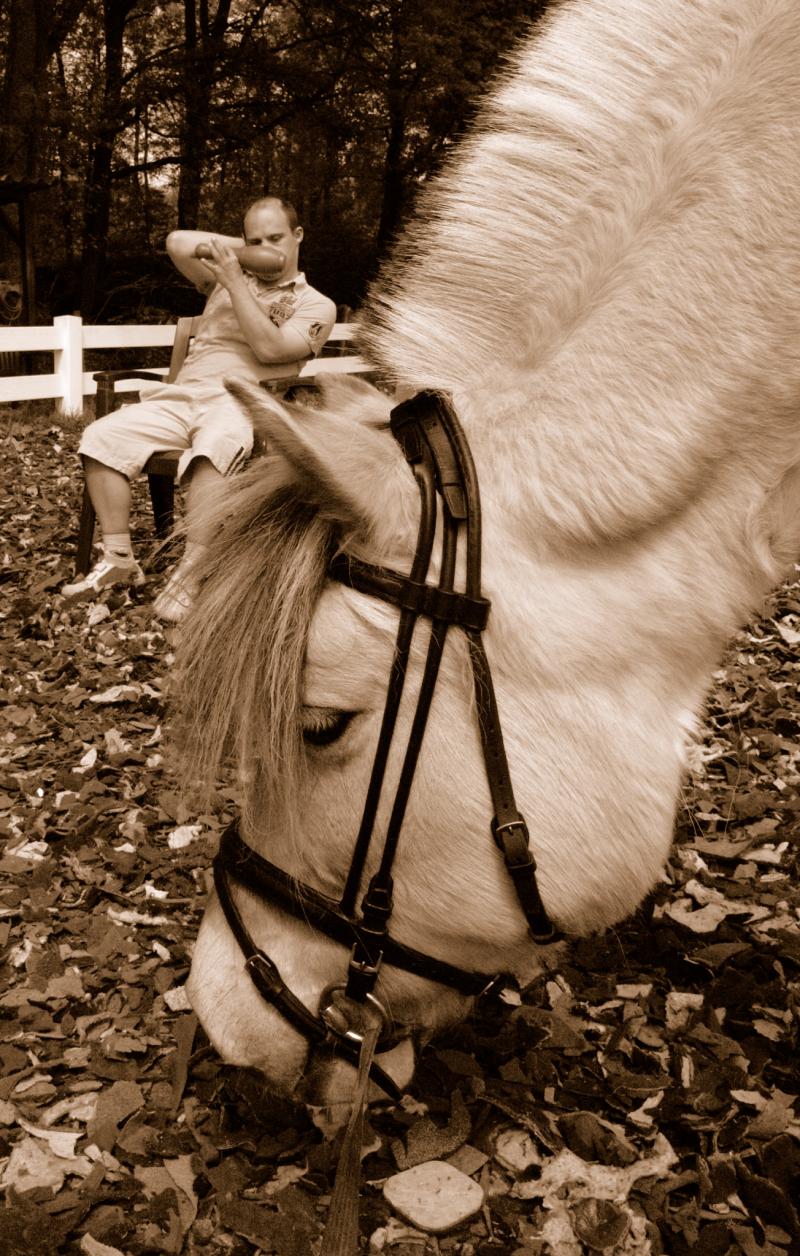 Equus is the Latin word for horse. Therapy signifies "healing process” in the widest sense. Therapy is often associated with illness. In relation to psychotherapeutic, psychosocial and pedagogic measures this means there is often still a certain reluctance to "have therapy”, or to "send one's child to have therapy”, as this would be tantamount to admitting mental illness, bringing with it a certain stigmatization. For similar reasons there is often hesitation in applying the term ‘therapy' to equine assisted measures that fall within these categories.
Equus is the Latin word for horse. Therapy signifies "healing process” in the widest sense. Therapy is often associated with illness. In relation to psychotherapeutic, psychosocial and pedagogic measures this means there is often still a certain reluctance to "have therapy”, or to "send one's child to have therapy”, as this would be tantamount to admitting mental illness, bringing with it a certain stigmatization. For similar reasons there is often hesitation in applying the term ‘therapy' to equine assisted measures that fall within these categories.
In the case of therapeutic riding (as advocated by SHP-E(NL)) we believe that we speak of equitherapy with good reason, as the activity in question is a targeted process tailored to the client's difficulties, which aims to reduce troubling conditions – and to thus systematically improve quality of life in the widest sense. To achieve this, an array of defined impact factors and a systematic process model are employed. For the purpose of a more positive slant this could also be formulated as "improving quality of life by means of a targeted processual alteration of unwanted conditions”. To further differentiate the equitherapeutic processes which take place in the pedagogical, psychological and psychotherapeutic fields, be it with adults or children and adolescents, one can make the following distinctions in terms of processes and clients:
• Processes which promote and support the (early) development (young children)
• Processes which complement development in the pedagogic context (mainly children and adolescents, but also adults)
• Processes which provide support in the psychosocial field (children, adolescents, adults)
• Processes which intervene in earlier development deficits through retroactive healing or regressive experience (children, adolescents, adults).
The function of the horse
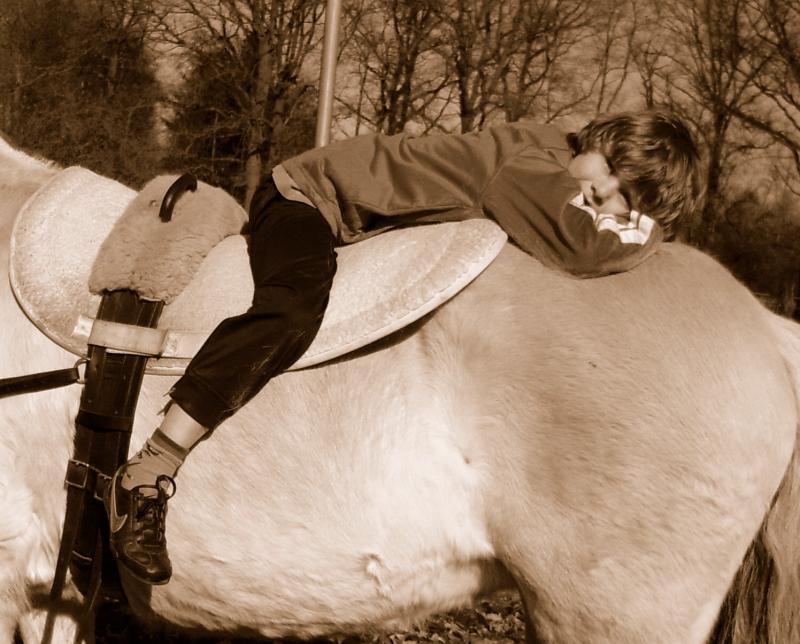 The therapy horse has a significant function in this process, thus enabling it to be more than just a "movement stimulus” or a gymnastics apparatus or "cuddly toy”. Based on the client's positive resources and set within the framework of a secure, well structured, yet stimulating triangular situation, the client should be given opportunities to make purposeful new experiences, gained through the relationship and movement dialogue with the horse and with the support of the therapist. These experiences occur at a cognitive level, but also at a sensory, emotional, motor and social level. The experiences open up new opportunities for the client, in terms of his behaviour and his view of himself and the environment in which he lives, and of his own interaction with this environment. The biomechanical, sensory and emotional interaction with the horse stimulates the development and training of a wide range of abilities (see forms of equitherapy). Thus development opportunities can be created and changes in behaviour initiated, which can subsequently be transferred to everyday life without the horse. The horse should have a central position in this process and should act as catalyst.
The therapy horse has a significant function in this process, thus enabling it to be more than just a "movement stimulus” or a gymnastics apparatus or "cuddly toy”. Based on the client's positive resources and set within the framework of a secure, well structured, yet stimulating triangular situation, the client should be given opportunities to make purposeful new experiences, gained through the relationship and movement dialogue with the horse and with the support of the therapist. These experiences occur at a cognitive level, but also at a sensory, emotional, motor and social level. The experiences open up new opportunities for the client, in terms of his behaviour and his view of himself and the environment in which he lives, and of his own interaction with this environment. The biomechanical, sensory and emotional interaction with the horse stimulates the development and training of a wide range of abilities (see forms of equitherapy). Thus development opportunities can be created and changes in behaviour initiated, which can subsequently be transferred to everyday life without the horse. The horse should have a central position in this process and should act as catalyst.
PSYCHOMOTILITY
Development and improvement of body awareness
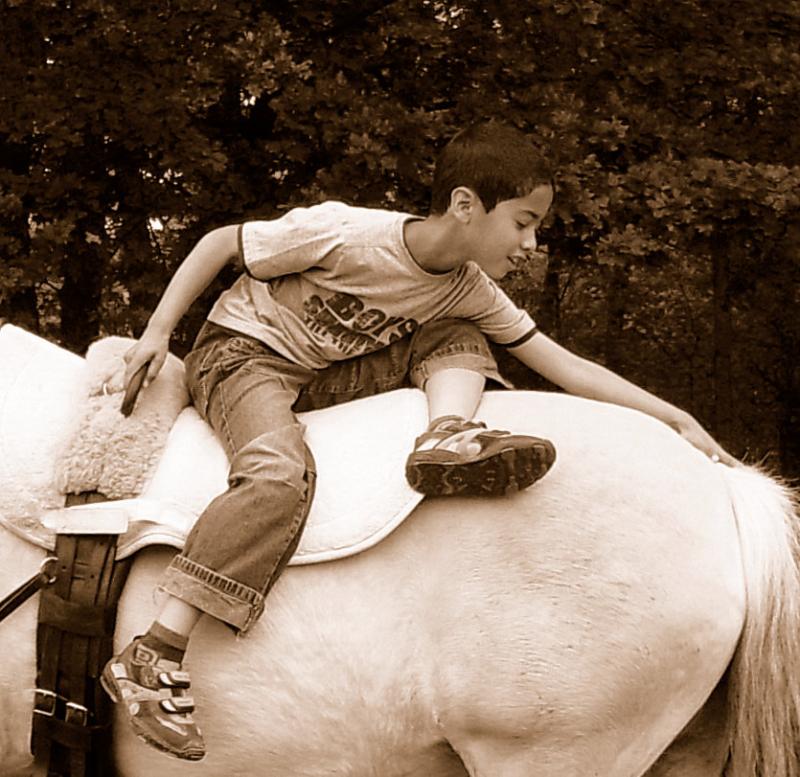 Body awareness encompasses the conscious and unconscious dimensions of the experiencing and processing of all body related sensations, feelings and perceptions. The body image is based on the subjective perception of the own body, on the individual's emotionally determined correlates and the way they are balanced out in relation to his body – and therefore on the subjective experience of his body.
Body awareness encompasses the conscious and unconscious dimensions of the experiencing and processing of all body related sensations, feelings and perceptions. The body image is based on the subjective perception of the own body, on the individual's emotionally determined correlates and the way they are balanced out in relation to his body – and therefore on the subjective experience of his body.
SENSORIMOTOR FUNCTION describes the interaction of motor function and the senses necessary for meaningful movement; the interplay of sensory and motor capacities. Also the direct guidance and control of the movements of living beings on the basis of sensory feedback. The connections between brain and nerve activity and movement sequences are studied in disciplines such as neuroscience, but also in sport science. The rebuilding of impaired sensorimotor functions for example is the aim of ergotherapy and physiotherapy. The concept of sensorimotor function development aims to train and improve coordination. It is a natural process that can be utilized for prevention and early intervention, as well as in therapy, to qualitatively improve the execution of movements and movement patterns.
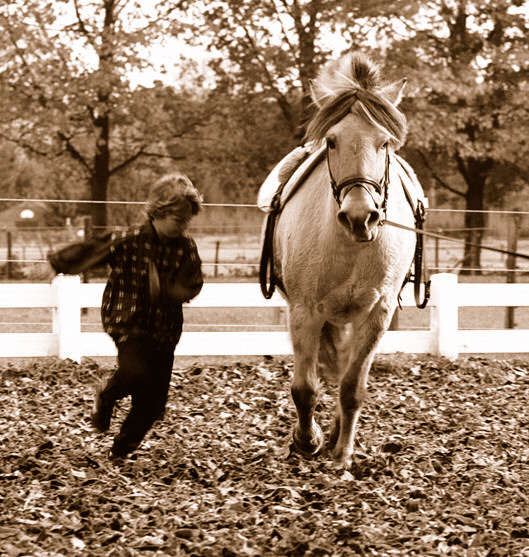 PSYCHOMOTILITY Describes the science and exercising of the connection of mental/psychological processes with the experience of movement. Psychomotility is the functional unity of psychological and motor processes, the close coupling of physical and mental/psychological feeling. Thus psychomotility describes an interpretation of human movement that goes beyond the biomechanical and physiological aspects by defining it as the result of a relationship process and the interplay of psychological, social and somatic factors, which can also influence individual personality predisposition. The term psychomotility stands for a holistic and development oriented concept that equally promotes perception and movement, as well as the emotional correlates. The concepts of psychomotility have found equal entrance into pedagogy and therapy, albeit with differing emphases (movement pedagogy, movement therapy, moto-pedagogy, psychomotor therapy...). Through Maria Montessori's concept of development support with the aid of movement, the theory of psychomotility emerged as early as the middle of the 19th century. In mid 20th century exercise therapy was introduced into child and adolescent psychiatry and in the 60's Kiphard (2000) enriched treatments for disabled people with psychomotility exercise programmes. Petzhold (1960) should also be named here as one of the pioneers, all of whom took as their starting point the assumption that a better relationship to one's own corporeality can lead to an increase in psychological and physical well-being. .
PSYCHOMOTILITY Describes the science and exercising of the connection of mental/psychological processes with the experience of movement. Psychomotility is the functional unity of psychological and motor processes, the close coupling of physical and mental/psychological feeling. Thus psychomotility describes an interpretation of human movement that goes beyond the biomechanical and physiological aspects by defining it as the result of a relationship process and the interplay of psychological, social and somatic factors, which can also influence individual personality predisposition. The term psychomotility stands for a holistic and development oriented concept that equally promotes perception and movement, as well as the emotional correlates. The concepts of psychomotility have found equal entrance into pedagogy and therapy, albeit with differing emphases (movement pedagogy, movement therapy, moto-pedagogy, psychomotor therapy...). Through Maria Montessori's concept of development support with the aid of movement, the theory of psychomotility emerged as early as the middle of the 19th century. In mid 20th century exercise therapy was introduced into child and adolescent psychiatry and in the 60's Kiphard (2000) enriched treatments for disabled people with psychomotility exercise programmes. Petzhold (1960) should also be named here as one of the pioneers, all of whom took as their starting point the assumption that a better relationship to one's own corporeality can lead to an increase in psychological and physical well-being. .Psycho- (Sensory- Socio-) motor activities with the horse
The horse offers a consolidation of experiences in the context of psychomotility. It enables intensive experience of self perception and self monitoring through the movement dialogue with the horse (and other group members), as well as the experience of mental and emotional correlates. 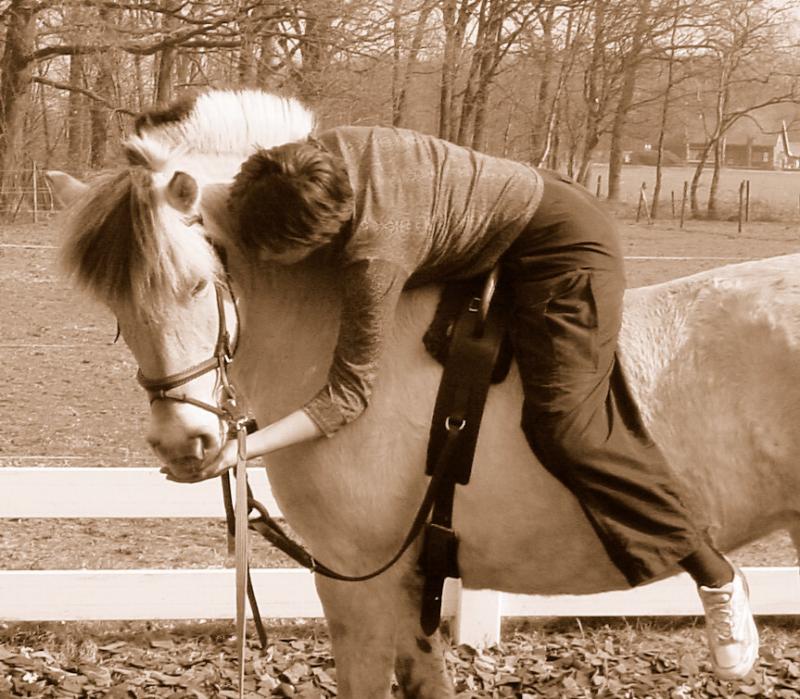 The intrinsic motivation to experiment with movement is encouraged by the horse, through motor stimulation and the positively perceived relationship to it. The movement dialogue with the horse and others promotes creativity. All the senses are addressed, triggering the neuronal and psychological processing of the sensory stimuli. This promotes experiences in the following domains: rhythmics, kinaesthetic perception, balance, muscle tension, posture, temperature, vibration, cutaneous senses, proprioception, vestibular sense, distance senses, sense of smell, seeing, hearing, tasting, as well as depth perception and perception of physical space. A deepened conscious experience of the horse's movement in unison with one's own movement and the movement of other participants in three-dimensional space promotes the development of motion awareness and awareness of one's own posture in dependence upon others. Furthermore it contributes to the development of a concept of space and time. These concepts influence cognitive processes in the long term and in many ways can also contribute to greater emotional stability. Working in dialogue with the horse in the circle or rectangle in nature and during stable chores promotes the perception of oneself, of others and of one's interaction with others in space and time. This takes place within the framework of a secure structure and most importantly within a safe relationship (emotional space). Thus skills can be developed and tested, and the image of oneself and the environment undergoes a lasting change, becoming more refined and sophisticated. By experiencing one's own ability to perform and the heightened self-awareness this brings, a picture develops of what one dares to do and what not (yet). Self-evaluation becomes more concrete – because it is verified in the dialogue with others (including the horse). Through the relationship with the horse, which acts as motivator, mirror and also transitional object, self-confidence and acceptance of one's own capabilities and limitations can often be attained more easily and definitely, compared to a setting where the aid of the horse is not included in the process. But above all, equitherapy, whether as support for children or psychotherapy for adults, is simply more enjoyable if it is undertaken in joyful movement together with a horse that one likes and to which one has a connection. However, in equitherapy it is not the intention to simply "plunge” the client into the interaction with the horse in an undifferentiated manner, in the name of a "holistic approach” and along the lines of: so much is being addressed, the client is bound to get something from it. Such an approach belongs to the perfectly meaningful domain of equine assisted activities, where the generally joyful activities with the horse can also lead to learning processes as a "side effect”. However, we are then not talking of equitherapy in the narrower sense.
The intrinsic motivation to experiment with movement is encouraged by the horse, through motor stimulation and the positively perceived relationship to it. The movement dialogue with the horse and others promotes creativity. All the senses are addressed, triggering the neuronal and psychological processing of the sensory stimuli. This promotes experiences in the following domains: rhythmics, kinaesthetic perception, balance, muscle tension, posture, temperature, vibration, cutaneous senses, proprioception, vestibular sense, distance senses, sense of smell, seeing, hearing, tasting, as well as depth perception and perception of physical space. A deepened conscious experience of the horse's movement in unison with one's own movement and the movement of other participants in three-dimensional space promotes the development of motion awareness and awareness of one's own posture in dependence upon others. Furthermore it contributes to the development of a concept of space and time. These concepts influence cognitive processes in the long term and in many ways can also contribute to greater emotional stability. Working in dialogue with the horse in the circle or rectangle in nature and during stable chores promotes the perception of oneself, of others and of one's interaction with others in space and time. This takes place within the framework of a secure structure and most importantly within a safe relationship (emotional space). Thus skills can be developed and tested, and the image of oneself and the environment undergoes a lasting change, becoming more refined and sophisticated. By experiencing one's own ability to perform and the heightened self-awareness this brings, a picture develops of what one dares to do and what not (yet). Self-evaluation becomes more concrete – because it is verified in the dialogue with others (including the horse). Through the relationship with the horse, which acts as motivator, mirror and also transitional object, self-confidence and acceptance of one's own capabilities and limitations can often be attained more easily and definitely, compared to a setting where the aid of the horse is not included in the process. But above all, equitherapy, whether as support for children or psychotherapy for adults, is simply more enjoyable if it is undertaken in joyful movement together with a horse that one likes and to which one has a connection. However, in equitherapy it is not the intention to simply "plunge” the client into the interaction with the horse in an undifferentiated manner, in the name of a "holistic approach” and along the lines of: so much is being addressed, the client is bound to get something from it. Such an approach belongs to the perfectly meaningful domain of equine assisted activities, where the generally joyful activities with the horse can also lead to learning processes as a "side effect”. However, we are then not talking of equitherapy in the narrower sense.
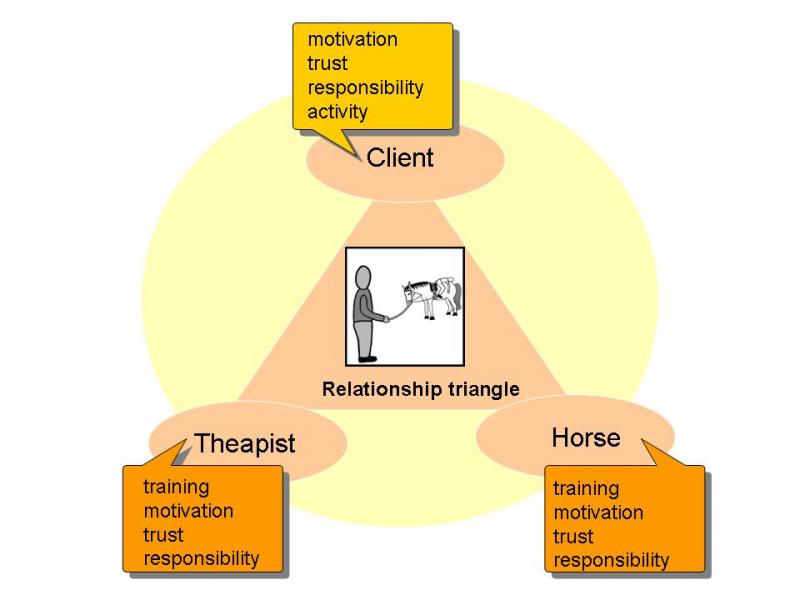 – (1) to regain their equilibrium through correction of past development processes, or (2) to improve their equilibrium through further development and the stabilizing of current development processes. This could be a young child that needs to be supported in its delayed development, or a child who is a slow learner and who can discover and learn to develop abilities. This could also be an adolescent who has lost his social bearings and who can experiment with a new form of responding to people, or the adult who needs support in an important phase of his life, or who seeks to process historically evolved conflicts due to great psychological strain. It is known from therapy research that a well balanced and positively experienced relationship to a therapist, who is perceived as professional, empathetic and confidence inspiring, is a significant factor in the success of a therapy. Only when this prerequisite is in place can the respective method and intervention technique of the therapist take hold by building on this therapeutic relationship, and thus facilitate the process. Transferred to the triangular relationship in the context of equitherapy this means: The therapist and the non-human co-therapist, the horse, must both be in balance themselves, and the relationship between them must be sound, as these are significant prerequisites for achieving the desired balance within the equitherapy. Only then can a relationship triangle between the three participants develop, where each has his tasks, responsibilities and rights. Within this relationship triangle a dialogue, or rather a trialogue, can then develop. This makes the desired process possible in the first place, as the client can then be open to it and enter into it.
– (1) to regain their equilibrium through correction of past development processes, or (2) to improve their equilibrium through further development and the stabilizing of current development processes. This could be a young child that needs to be supported in its delayed development, or a child who is a slow learner and who can discover and learn to develop abilities. This could also be an adolescent who has lost his social bearings and who can experiment with a new form of responding to people, or the adult who needs support in an important phase of his life, or who seeks to process historically evolved conflicts due to great psychological strain. It is known from therapy research that a well balanced and positively experienced relationship to a therapist, who is perceived as professional, empathetic and confidence inspiring, is a significant factor in the success of a therapy. Only when this prerequisite is in place can the respective method and intervention technique of the therapist take hold by building on this therapeutic relationship, and thus facilitate the process. Transferred to the triangular relationship in the context of equitherapy this means: The therapist and the non-human co-therapist, the horse, must both be in balance themselves, and the relationship between them must be sound, as these are significant prerequisites for achieving the desired balance within the equitherapy. Only then can a relationship triangle between the three participants develop, where each has his tasks, responsibilities and rights. Within this relationship triangle a dialogue, or rather a trialogue, can then develop. This makes the desired process possible in the first place, as the client can then be open to it and enter into it.
The cyclic process model and its impact factors
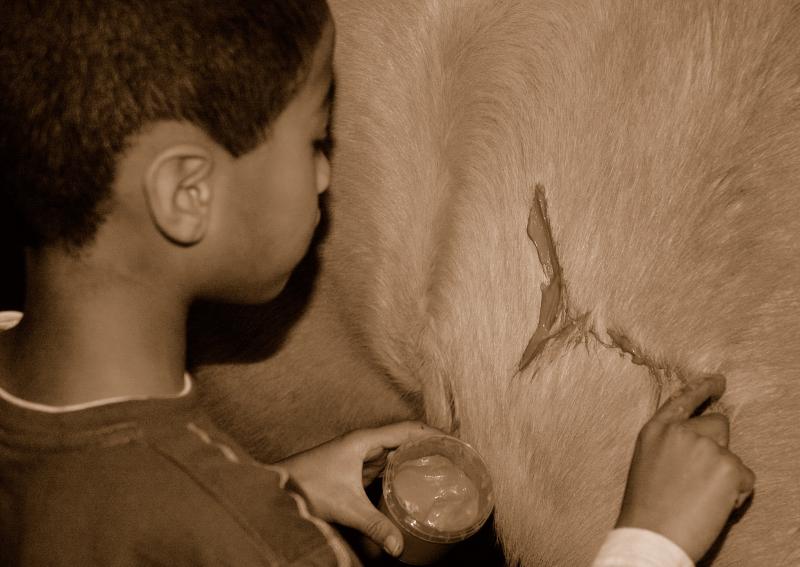 The starting point for all concepts (of equine assisted psychosocial and psychomotor development support, pedagogic support and psychotherapeutic work) is that one wants to offer the client the opportunity to embark on a journey of discovery with horse and therapist, in a setting that is new for him and has no negative connotations. The aim is for the client to discover himself and his capabilities and limitations, with the horse being assigned a significant role. The process shows up alternatives to normal situations and interactions in everyday life. It enables experiences that can be processed with support from the therapist, and can be integrated into daily life, to allow an improvement in the quality of life. A prerequisite for this is the assessment of the wishes or problems of the client. Together with the client the therapist can formulate the objectives for the upcoming equitherapy, by bringing together his specialized knowledge stemming from his primary profession, his awareness of the client's difficulties, and his knowledge of the equitherapy treatment model. Thus the therapist can closely formulate the most suitable provision for this particular client. This provision will involve a combination of impact factors relating to a particular therapy model. These factors are then utilized systematically.
The starting point for all concepts (of equine assisted psychosocial and psychomotor development support, pedagogic support and psychotherapeutic work) is that one wants to offer the client the opportunity to embark on a journey of discovery with horse and therapist, in a setting that is new for him and has no negative connotations. The aim is for the client to discover himself and his capabilities and limitations, with the horse being assigned a significant role. The process shows up alternatives to normal situations and interactions in everyday life. It enables experiences that can be processed with support from the therapist, and can be integrated into daily life, to allow an improvement in the quality of life. A prerequisite for this is the assessment of the wishes or problems of the client. Together with the client the therapist can formulate the objectives for the upcoming equitherapy, by bringing together his specialized knowledge stemming from his primary profession, his awareness of the client's difficulties, and his knowledge of the equitherapy treatment model. Thus the therapist can closely formulate the most suitable provision for this particular client. This provision will involve a combination of impact factors relating to a particular therapy model. These factors are then utilized systematically.
A PHASED AND PROGRESSIVE CYCLICAL PROCESS:
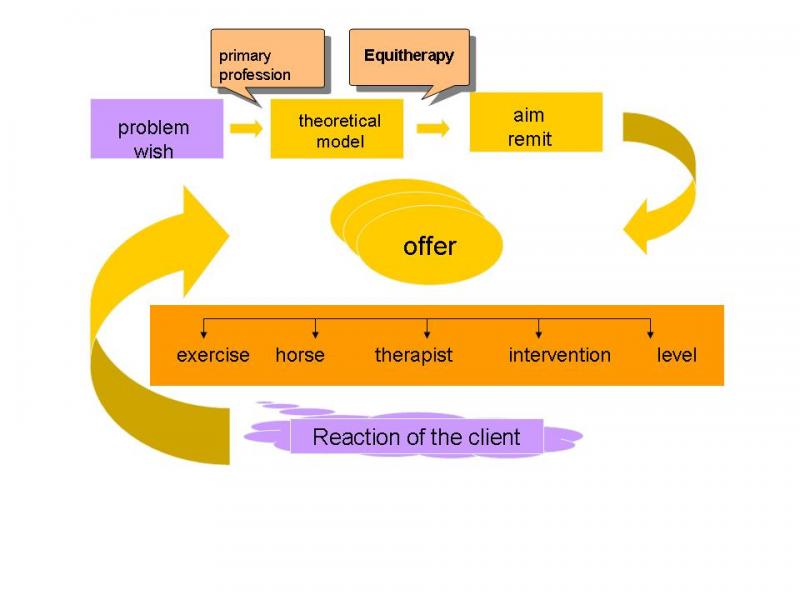
The therapy horse: not a passive accessory that can be operated at the touch of a button
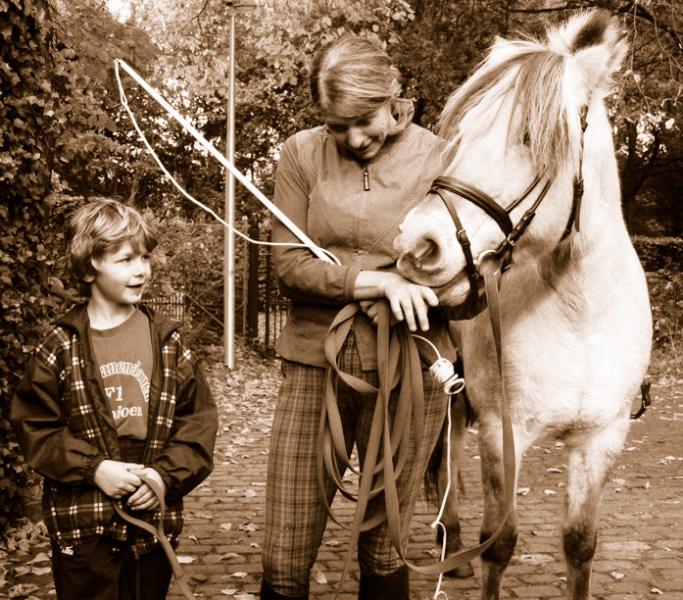 If the horse is not simply to be employed as an "accessory” – comparable to a mobile piece of gymnastics or play equipment expected to function at the touch of a button – but instead forms an individual, active part of the trialogue, then consequently it is imperative that therapist and horse have a relationship on which their collaboration in the trialogue with the client can build. The way in which this relationship functions acts as a model for the client: "The way these two deal with each other and understand each other is the way that they will deal with me too. I can trust the horse and the therapist the way they trust each other too. The consideration with which they treat each other is the consideration they will treat me with too.” In this context the idea of balance can and should also be taken quite literally, as we work holistically with the body and with movement. During the training of the therapy horse the therapist should thus also be able to assist his horse in finding its balance as a riding and vaulting horse – and later as a therapy horse. This is meant in the hippic-technical sense as well in the psychological sense. It requires horse and therapist to occupy themselves with each other and undergo training together – also outside of therapy times. Both should be able to rely on each other, and know what they can expect of each other. This requirement does not preclude possible conflicts, however they should be resolved before the client becomes involved. The horse within the trialogue will react to a possible imbalance of the therapist
If the horse is not simply to be employed as an "accessory” – comparable to a mobile piece of gymnastics or play equipment expected to function at the touch of a button – but instead forms an individual, active part of the trialogue, then consequently it is imperative that therapist and horse have a relationship on which their collaboration in the trialogue with the client can build. The way in which this relationship functions acts as a model for the client: "The way these two deal with each other and understand each other is the way that they will deal with me too. I can trust the horse and the therapist the way they trust each other too. The consideration with which they treat each other is the consideration they will treat me with too.” In this context the idea of balance can and should also be taken quite literally, as we work holistically with the body and with movement. During the training of the therapy horse the therapist should thus also be able to assist his horse in finding its balance as a riding and vaulting horse – and later as a therapy horse. This is meant in the hippic-technical sense as well in the psychological sense. It requires horse and therapist to occupy themselves with each other and undergo training together – also outside of therapy times. Both should be able to rely on each other, and know what they can expect of each other. This requirement does not preclude possible conflicts, however they should be resolved before the client becomes involved. The horse within the trialogue will react to a possible imbalance of the therapist |
Therapie
Situations from the Equitherapy sessions SHP |
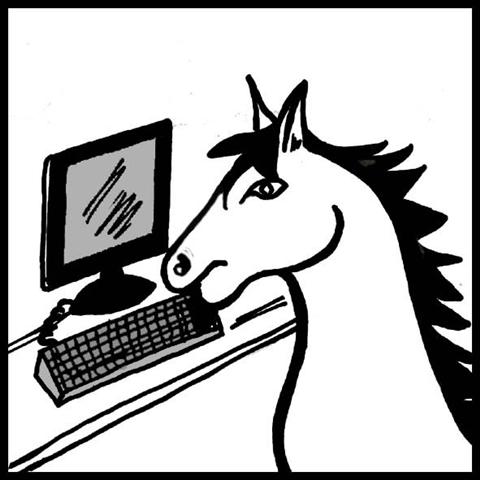 Copyright: No part of this publication may be reproduced or published by print, microfilm placement on internet or by any means without the prior permission of the publisher. Citation is allowed following the scientific citation rules. Author: U.Thiel www.equitherapie.org Date of update
Copyright: No part of this publication may be reproduced or published by print, microfilm placement on internet or by any means without the prior permission of the publisher. Citation is allowed following the scientific citation rules. Author: U.Thiel www.equitherapie.org Date of update

